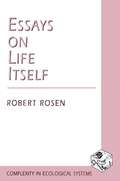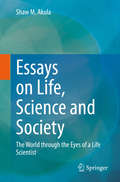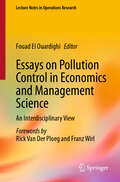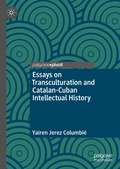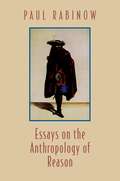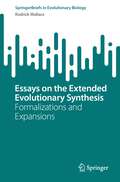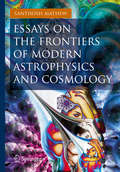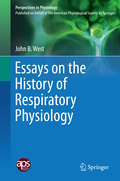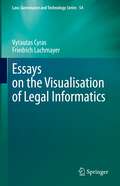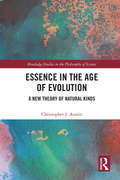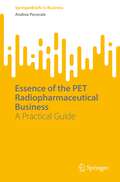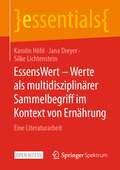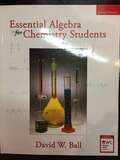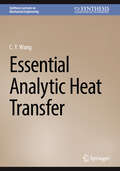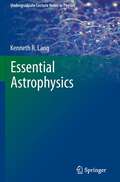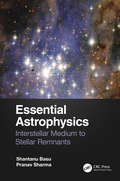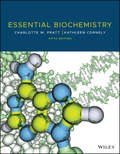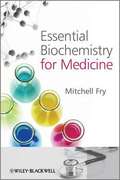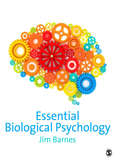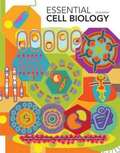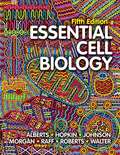- Table View
- List View
Essays on Life Itself (Complexity in Ecological Systems)
by Robert RosenCompiling twenty articles on the nature of life and on the objective of the natural sciences, this remarkable book complements Robert Rosen's groundbreaking Life Itself—a work that influenced a wide range of philosophers, biologists, linguists, and social scientists. In Essays on Life Itself, Rosen takes to task the central objective of the natural sciences, calling into question the attempt to create objectivity in a subjective world and forcing us to reconsider where science can lead us in the years to come.
Essays on Life, Science and Society: The World through the Eyes of a Life Scientist
by Shaw M. AkulaThis collection of nine essays provides an entertaining and thoughtful glimpse into trending topics in our lives. The author, Dr. Akula, tackles questions on life, science, and society from a biologist’s perspective. The book covers a broad range of topics, including common questions with complex answers intermixed with some religion and humor, making it a great read to give your brain cells a boost. The field of Science is massive - in fact, it’s the size of the universe, which means picking just a few topics to discuss is no mean feat. This book is a start, but there is more to come as Dr. Akula explores various subjects to discuss and shed new light on. This collection of essays will appeal to scientists, and to lay readers with an interest in the natural sciences. Its goal is to ensure that science isn’t accessible to only a few people, but is instead disseminated to many. After all, a Smart World is the key to a Better Tomorrow and a Brighter Future.
Essays on Pollution Control in Economics and Management Science: An Interdisciplinary View (Lecture Notes in Operations Research)
by Fouad El OuardighiThe book features contributions that address both environmental economics and environmental management. It presents a novel dynamic modeling framework for environmental economics in which environmental absorption efficiency is considered as a time-dependent variable with its own dynamics. It also introduces several extensions and applications of the model, including the possibility of including self-regenerating environmental absorption efficiency, non-cooperative transboundary issues with two superimposed free-rider behaviors (i.e., emissions reduction and restoration efforts), and deforestation. In the environmental management context, it puts forward an entirely new dynamic modeling framework. Unlike static approaches, the model considers both flow and stock variables, reflecting the accumulation of pollution over time. In turn, the book assesses sustainable configurations for supply chain competition, providing mathematical insights and managerial recommendations that integrate accumulated pollution aspects and associated negative externalities. Overall, the book calls for combining environmental economics and environmental management in order to arrive at more realistic, empirically grounded models. Given its focus, the book offers a valuable resource for researchers and graduate students with an interest in addressing pollution control challenges in the fields of economics and management science.
Essays on Transculturation and Catalan-Cuban Intellectual History
by Yairen Jerez ColumbiéThis book examines the cultural production of Catalan intellectuals in Cuba through a reading of texts and journeys that show the contrapuntal relationship between transcultural identities and narratives of nationhood. Both the concept of transculturation and its instrumentalization to tame conflict within nationalist projects are problematic. By uncovering and examining the contradictions between the fluid character of identities in the Cuban context of the first half of the twentieth century and nationalist discourses, within both the Catalanist community of Havana and Cuban society, this book joins wider debates about identities.
Essays on the Anthropology of Reason
by Paul RabinowThis collection of essays explains and encourages new reflection on Paul Rabinow's pioneering project to anthropologize the West. His goal is to exoticize the Western constitution of reality, emphasize those domains most taken for granted as universal, and show how their claims to truth are linked to particular social practices, hence becoming effective social forces. He has recently begun to focus on the core of Western rationality, in particular the practices of molecular biology as they apply to our understanding of human nature. This book moves in new directions by posing questions about how scientific practice can be understood in terms of ethics as well as in terms of power. The topics include how French socialist urban planning in the 1930s engineered the transition from city planning to life planning; how the discursive and nondiscursive practices of the Human Genome Project and biotechnology have refigured life, labor, and language; and how a debate over patenting cell lines and over the dignity of life required secular courts to invoke medieval notions of the sacred. Building on an ethnographic study of the invention of the polymerase chain reaction--which enables the rapid production of specific sequences of DNA in millions of copies Rabinow, in the final essay, reflects in dialogue with biochemist Tom White on the place of science in modernity, on science as a vocation, and on the differences between the human and natural sciences.
Essays on the Extended Evolutionary Synthesis: Formalizations and Expansions (SpringerBriefs in Evolutionary Biology)
by Rodrick WallaceFrom the ‘punctuated equilibrium' of Eldrege and Gould, through Lewontin's ‘triple helix' and the various visions and revisions of the Extended Evolutionary Synthesis (EES) of Laland and others, both data and theory have demanded an opening-up of the 1950's Evolutionary Synthesis that so firmly wedded evolutionary theory to the mathematics of gene frequency analysis. It can, however, be argued that a single deep and comprehensive mathematical theory may simply not be possible for the almost infinite varieties of evolutionary process active at and across the full range of scales of biological, social, institutional, and cultural phenomena. Indeed, the case history of 'meme theory' should have raised a red flag that narrow gene-centered models of evolutionary process may indeed have serious limitations. What is attempted here is less grand, but still broader than a gene-centered analysis. Following the instruction of Maturana and Varela that all living systems are cognitive, in a certain sense, and that living as a process is a process of cognition, the asymptotic limit theorems of information and control theories that bound all cognition provide a basis for constructing an only modestly deep but wider-ranging series of probability models that might be converted into useful statistical tools for the analysis of observational and experimental data related to evolutionary process. The line of argument in this series of interrelated essays proves to be surprisingly direct.
Essays on the Frontiers of Modern Astrophysics and Cosmology
by Santhosh MathewThis book is a collection of fourteen essays that describe an inspiring journey through the universe and discusses popular science topics that modern physics and cosmology are struggling to deal with. What is our place in the universe and what happens in the magnificent cosmos where we exist for a brief amount of time. In an unique way that incorporates mythological and philosophical perspectives, the essays in this work address the big questions of what the universe is, how it came into being, and where it may be heading. This exciting adventure is a rich scientific history of elegant physics, mathematics, and cosmology as well as a philosophical and spiritual pursuit fueled by the human imagination.
Essays on the History of Respiratory Physiology
by John B. WestThis book consists of 23 essays about prominent people and events in the history of respiratory physiology. It provides a first-hand chronicle of the advancements made in respiratory physiology starting with Galen and the beginnings of Western physiology. The volume covers every aspect of the evolution of this important area of knowledge: pulmonary circulation, Boyle's Law, pulmonary capillaries and alveoli, morphology, gas exchange and blood flow, mechanics, control of ventilation, and comparative physiology. The book emphasizes societal and philosophical aspects of the history of science. Although it concentrates on physiology, it also describes how cultural movements, such as The Enlightenment, shaped the researchers discussed. This book is published on behalf of the American Physiological Society by Springer. Access to APS books published with Springer is free to APS members.
Essays on the Visualisation of Legal Informatics (Law, Governance and Technology Series #54)
by Vytautas Cyras Friedrich LachmayerBoth legal scholars and computer scientists will be curious to know how the gap between law and computing can be bridged. The law, and also jurisprudence, is based on language, and is mainly textual. Every syntactic system has its semantic range, and so does language, which in law achieves a high degree of professional precision. The use of visualisations is a syntactic supplement and opens up a new understanding of legal forms. This understanding was reinforced by the paradigm shift from textual law to legal informatics, in which visual formal notations are decisive. The authors have been dealing with visualisation approaches for a long time and summarise them here for discussion. In this book, a multiphase transformation from the legal domain to computer code is explored. The authors consider law enforcement by computer. The target view is that legal machines are legal actors that are capable of triggering institutional facts. In the visualisation of statutory law, an approach called Structural Legal Visualisation is presented. Specifically, the visualisation of legal meaning is linked with tertium comparationis, the third part of the comparison. In a legal documentation system, representing one legal source with multiple documents is viewed as a granularity problem. The authors propose to supplement legislative documents ex ante with explicit logic-oriented information in the form of a mini thesaurus. In contrast to so-called strong relations such as synonymy, antonymy and hypernymy/hyponymy, one should consider weak relations: (1) dialectical relations, a term of dialectical antithesis; (2) context relations; and (3) metaphorical relations, which means the use of metaphors for terms. The chapters trace topics such as the distinction between knowledge visualisation and knowledge representation, the visualisation of Hans Kelsen’s Pure Theory of Law, the separation of law and legal science, legal subsumption, legal relations, legal machines, encapsulation, compliance, transparency, standard cases and hard cases.
Essence in the Age of Evolution: A New Theory of Natural Kinds (Routledge Studies in the Philosophy of Science)
by Christopher J. AustinThis book offers a novel defence of a highly contested philosophical position: biological natural kind essentialism. This theory is routinely and explicitly rejected for its purported inability to be explicated in the context of contemporary biological science, and its supposed incompatibility with the process and progress of evolution by natural selection. Christopher J. Austin challenges these objections, and in conjunction with contemporary scientific advancements within the field of evolutionary-developmental biology, the book utilises a contemporary neo-Aristotelian metaphysics of "dispositional properties", or causal powers, to provide a theory of essentialism centred on the developmental architecture of organisms and its role in the evolutionary process. By defending a novel theory of Aristotelian biological natural kind essentialism, Essence in the Age of Evolution represents the fresh and exciting union of cutting-edge philosophical insight and scientific knowledge.
Essence of the PET Radiopharmaceutical Business: A Practical Guide (SpringerBriefs in Business)
by Andrea PecoraleThis book explores the organizational and operational activities of real Positron Emission Tomography (PET) radiopharmaceutical manufacturing. Centered around the author’s professional experience, this book specifically explores: (1) the selection and preservation of operational and managerial personnel; (2) the alignment of production plans to consumer needs while still achieving financial goals; and (3) the positive and negative aspects of different operation management methods for direct and third-party production. The book offers a valuable reference for hospital managers, professionals and consultants interested or involved in developing a radiopharmaceutical facility/business or personalized medicine and special productions.
EssensWert - Werte als multidisziplinärer Sammelbegriff im Kontext von Ernährung: Eine Literaturarbeit (essentials)
by Karolin Höhl Jana Dreyer Silke LichtensteinIn den aktuellen Diskursen um die Transformation des Ernährungssystems sind Werte omnipräsent. Jedoch werden sie dabei nicht immer ausdrücklich kenntlich gemacht. Häufig kommt es zu Be- und Abwertungen von Handlungen und Denkweisen, teils unter Heranziehung dichotomer Ernährungsnormen. Doch die Transformation bedingt einen konsensuell getragenen Wertewandel, der u. a. über Empathie und Mäßigung Lösungswege ebnet und das Wohlergehen aller adressiert. Dafür sind objektive Beobachtungen ohne normative Direktiven notwendig. Die Intention des vorliegenden Textes war daher die Auseinandersetzung mit verschiedenen Konzeptionen von Werten unterschiedlicher Disziplinen, um Reichweiten und Grenzen verschiedener Auffassungen im Ernährungskontext zu erörtern. Zur Information: Dies ist ein Open-Access-Buch.
Essential Algebra for Chemistry Students
by David W. BallAvailable for packaging with any CENGAGE textbook or available separately for a minimal cost at CENGAGEbrain.com, this short book is intended for students who lack confidence and/or competency in the essential mathematics skills necessary to survive in general chemistry. Each chapter focuses on a specific type of skill and has worked-out examples to show how these skills translate to chemical problem solving.
Essential Analytic Heat Transfer (Synthesis Lectures on Mechanical Engineering)
by C.Y. WangThis book discusses heat transfer, which is an important topic in all physical phenomena that involve thermal energy transport. The focus is on the three major means of heat transfer: conduction, convection, and radiation. New materials, methods, and insights are presented that reflect the author’s contributions in this area. After many years of experience in teaching and research, Dr. Wang has refined many useful analytic methods to treat thermo-fluid problems. Certain physical truths can only be revealed by analysis, and this book focuses on analytic means to solve heat transfer problems, rather than numerical and experimental methods. Although computer numerical solutions are becoming quite efficient, analytical solutions are still needed for numerical accuracy. This book is written in concise and understandable terms and is useful to practicing scientists and engineers and also serves as an ideal textbook for graduate students. For best results, readers should have completedundergraduate courses in differential equations, introductory heat transfer, and elementary fluid mechanics and should know how to use simple computer library functions such as integration and matrix inversion.
Essential Astrophysics
by Kenneth R. LangEssential Astrophysics is a book to learn or teach from, as well as a fundamental reference volume for anyone interested in astronomy and astrophysics. It presents astrophysics from basic principles without requiring any previous study of astronomy or astrophysics. It serves as a comprehensive introductory text, which takes the student through the field of astrophysics in lecture-sized chapters of basic physical principles applied to the cosmos. This one-semester overview will be enjoyed by undergraduate students with an interest in the physical sciences, such as astronomy, chemistry, engineering or physics, as well as by any curious student interested in learning about our celestial science. The mathematics required for understanding the text is on the level of simple algebra, for that is all that is needed to describe the fundamental principles. The text is of sufficient breadth and depth to prepare the interested student for more advanced specialized courses in the future. Astronomical examples are provided throughout the text, to reinforce the basic concepts and physics, and to demonstrate the use of the relevant formulae. In this way, the student learns to apply the fundamental equations and principles to cosmic objects and situations. All of the examples are solved with the rough accuracy needed to portray the basic result. Astronomical and physical constants and units as well as the most fundamental equations can be found in the appendix. Essential Astrophysics goes beyond the typical textbook by including references to the seminal papers in the field, with further reference to recent applications, results, or specialized literature. There are fifty set-aside focus elements that enhance and augment the discussion with fascinating details. They include the intriguing historical development of particular topics and provide further astrophysics equations or equations for other topics. Kenneth Lang is a world-renowned author on astrophysics. His books for professional astrophysicists as well as for students and the interested layman are highly acclaimed.
Essential Astrophysics: Interstellar Medium to Stellar Remnants
by Shantanu Basu Pranav SharmaThis book takes a reader on a tour of astronomical phenomena: from the vastness of the interstellar medium, to the formation and evolution of stars and planetary systems, through to white dwarfs, neutron stars, and black holes, the final objects of the stellar graveyard. At its heart, this book is a journey through the evolutionary history of the birth, life, and death of stars, but detours are also made to other related interesting topics. This highly accessible story of the observed contents of our Galaxy includes intuitive explanations, informative diagrams, and basic equations, as needed. It is an ideal guide for undergraduates with some physics and mathematics background who are studying astronomy and astrophysics. It is also accessible to interested laypeople, thanks to its limited equations. Key features: Includes coverage of some of the latest exciting research from the field, including star formation, exoplanets, and black holes Can be utilised as a stand-alone textbook for a one-term course or as a supplementary textbook for a more comprehensive course on astronomy and astrophysics Authored by a team respected for research, education, and outreach Shantanu Basu is an astrophysicist and a professor at The University of Western Ontario, Canada. He is known for research contributions on the formation of gravitationally-collapsed objects in the universe: stars, planets, brown dwarfs, and supermassive black holes. He is one of the originators of the migrating embryo scenario of episodic accretion onto young stars. He has been recognized for his teaching excellence and his contributions to the astronomical community include organizing many conferences and training schools. Pranav Sharma is an astronomer and science historian known for his work on the history of the Indian Space Program. He has curated the Space Museum at the B. M. Birla Science Centre (Hyderabad, India). He is in-charge of the history of Indo-French scientific partnership project supported by the Embassy of France in India. He is a national-award-winning science communicator and has extensively worked on the popularization of astronomy education in India.
Essential Biochemistry
by Charlotte W. Pratt Kathleen CornelyEssential Biochemistry, 5th Edition is comprised of biology, pre-med and allied health topics and presents a broad, but not overwhelming, base of biochemical coverage that focuses on the chemistry behind the biology. This revised edition relates the chemical concepts that scaffold the biology of biochemistry, providing practical knowledge as well as many problem-solving opportunities to hone skills. Key Concepts and Concept Review features help students to identify and review important takeaways in each section.
Essential Biochemistry for Medicine
by Mitchell FryThis text addresses the growing need for a new kind of textbook for medical and biomedical undergraduates that presents a fully integrated approach to biochemistry and medicine, rather than covering biochemistry on a topic by topic basis with a smattering of 'medical cases' to demonstrate relevance. The majority of pre-clinical medical students do not need a detailed biochemistry text book, but rather "biochemistry as a basis" or as an "add-on". The major challenge for them is to integrate biochemical knowledge, to clinical application in the understanding of the etiology of diseases, their diagnosis and treatment.Essential Biochemistry for Medicine is not intended to be an exhaustive, comprehensive reference; rather a concise, accessible guide that will help first year students, from a wide spectrum of backgrounds, gain a good basic understanding of the biochemistry behind common medical disorders. It integrates biochemistry with clinical applications and the understanding of the etiology of diseases, their diagnosis and treatment. Each chapter includes a concise and simple introduction to the relevant biochemistry and terminology to reinforce what biomedical students have covered, orientate them and encourage them to consider the medical context; whilst at the same time outlining the biochemistry in a simple, "must know" format, for medical students before directing them to the all important clinical considerations.Key Features:A fully integrated approach to give students a basic understanding of the biochemistry behind common medical disordersConcise, accessible and well-written with numerous clear illustrations in full colour throughoutUses 'FOCUS' sections to expand on certain areas such as diabetes, HIV and obesityIncludes links and quick references for those wanting a broader knowledge of each topic
Essential Biological Psychology
by Jim BarnesDrawing on the latest exciting research, Essential Biological Psychology provides students with a solid grasp of the relationship between mind and behaviour, and a detailed understanding of the underlying structure and physiological mechanisms that underpin it. The functions of the nervous system are explained and implications for health are explored. Throughout the book, Jim Barnes encourages students to evaluate essential concepts and theoretical issues. <P><P> Features include:<P> * key concepts highlighted throughout the text enables students to grasp the fundamental knowledge and understanding of the structures and functions of the human nervous system that are relevant to the study of psychology <P> * the snapshot of key studies detailed in the textboxes allow critical evaluation of the role of physiology in human behaviour against a backdrop of up to date research <P> * clear explanations of the key methods in the text give students an appreciation of the contributions made by the different approaches and research methods that are used in biological psychology <P> * memory maps and diagrams within the text encourage learning and allow students to formulate memory aids to assist recall in exam conditions <P> * a companion website found at www.sagepub.co.uk/barnes consists of PowerPoint lecture slides and a testbank for teachers (50 questions per chapter) as well as interactive self-assessment testbank for students (10 questions per chapter)
Essential Biological Psychology (Essential Psychology)
by G Neil MartinThe Essential Psychology Series bridges the gap between simple introductory texts aimed at pre-university students and higher level textbooks for upper level undergraduates. Each volume in the series is designed to provide concise yet up-to-date descriptions of the major areas of psychology for first year undergraduates or students taking psychology as a supplement to other courses of study. The authors, who are acknowledged experts in their field, explain the basics carefully and engagingly without the over-simplification often found in introductory textbooks, at the same time providing the reader with insights into current thinking.Essential Biological Psychology is an accessible, well-illustrated and well-written account of the study of the role of the body in behaviour and the effect of behaviour on the working of the body. Covering all the major topics within biopsychology, and evaluating the most up-to-date findings, particularly within neuroscience and neuroimaging research, this textbook is essential reading for first and second level undergraduates taking courses in biological or physiological psychology as well as anyone studying courses in neuropsychology or behavioural neuroscience.
Essential Biomaterials Science
by David WilliamsThis groundbreaking single-authored textbook equips students with everything they need to know to truly understand the hugely topical field of biomaterials science, including essential background on the clinical necessity of biomaterials, relevant concepts in biology and materials science, comprehensive and up-to-date coverage of all existing clinical and experimental biomaterials, and the fundamental principles of biocompatibility. It features extensive case studies interweaved with theory, from a wide range of clinical disciplines, equipping students with a practical understanding of the phenomena and mechanisms of biomaterials performance; a whole chapter dedicated to the biomaterials industry itself, including guidance on regulations, standards and guidelines, litigation, and ethical issues to prepare students for industry; informative glossaries of key terms, engaging end-of-chapter exercises and up-to-date lists of recommended reading. Drawing on the author's forty years' experience in biomaterials, this is an indispensable resource for students studying these lifesaving technological advances.
Essential Cell Biology
by Keith Roberts Dennis Bray Alexander Johnson Julian Lewis Martin Raff Peter Walter Bruce Alberts Karen HopkinEssential Cell Biology provides an accessible introduction to the fundamental concepts of cell biology. Its lively writing and exceptional illustrations make it the ideal textbook for a first course in cell and molecular biology. The text and figures are easy-to-follow, accurate, clear, and engaging for the introductory student. Molecular detail has been kept to a minimum in order to provide the reader with a cohesive, conceptual framework of the basic science that underlies our current understanding of biology. The Third Edition is thoroughly updated scientifically, yet maintains the academic level and size of the previous edition. The book is accompanied by a Media DVD-ROM with over 130 animations and videos, all the figures from the book, and a new self-test quizzing feature for students.
Essential Cell Biology
by Keith Roberts David Morgan Alexander Johnson Martin Raff Peter Walter Bruce Alberts Karen HopkinCell biology is taught in classrooms around the world to provide students with a firm conceptual grounding in biology. This text provides basic, core knowledge about how cells work and uses colour images and diagrams to emphasize concepts and aid understanding.
